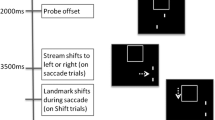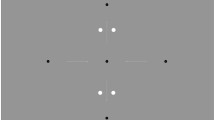Abstract
During saccadic eye movements, the visual world shifts rapidly across the retina. Perceptual continuity is thought to be maintained by active neural mechanisms that compensate for this displacement, bringing the presaccadic scene into a postsaccadic reference frame. Because of this active mechanism, objects appearing briefly around the time of the saccade are perceived at erroneous locations, a phenomenon called perisaccadic mislocalization. The position and direction of localization errors can inform us about the different reference frames involved. It has been found, for example, that errors are not simply made in the direction of the saccade but directed toward the saccade target, indicating that the compensatory mechanism involves spatial compression rather than translation. A recent study confirmed that localization errors also occur in the direction orthogonal to saccade direction, but only for eccentricities far from the fovea, beyond the saccade target. This spatially specific pattern of distortion cannot be explained by a simple compression of space around the saccade target. Here I show that a change of reference frames (i.e., translation) in cortical (logarithmic) coordinates, taking into account the cortical magnification factor, can accurately predict these spatial patterns of mislocalization. The flashed object projects onto the cortex in presaccadic (fovea-centered) coordinates but is perceived in postsaccadic (target-centered) coordinates.
Similar content being viewed by others
References
Curcio CA, Allen KA (1990) Topography of ganglion cells in human retina. J Comp Neurol 300(1):5–25
Dougherty RF, Koch VM, Brewer AA, Fischer, B, Modersitzki J, Wandell BA (2003) Visual field representations and locations of visual areas V 1/2/3 in human visual cortex. J Vis 3(10):586–598
Duhamel JR, Colby CL, Goldberg ME (1992) The updating of the representation of visual space in parietal cortex by intended eye movements. Science 255(5040):90–92
Hamker FH (2003) The reentry hypothesis: linking eye movements to visual perception. J Vis 3(11):808–816
Hamker FH, Zirnsak M, Lappe M (2004) A computational model of saccadic mislocalization based on spatial reentry. In: Proceedings of the 4th annual meeting of the vision sciences society, Sarasota, FL
Honda H (1989) Perceptual localization of visual stimuli flashed during saccades. Percept Psychophysiol 45(2):162–174
Honda H (1993) Saccade-contingent displacement of the apparent position of visual stimuli flashed on a dimly illuminated structured background. Vis Res 33(5–6):709–716
Horton JC, Hoyt WF (1991) The representation of the visual field in human striate cortex. A revision of the classic Holmes map. Arch Ophthalmol 109(6):816–824
Kaiser M, Lappe M (2004) Perisaccadic mislocalization orthogonal to saccade direction. Neuron 41(2):293–300
Krekelberg B, Kubischik M, Hoffmann KP, Bremmer F (2003) Neural correlates of visual localization and perisaccadic mislocalization. Neuron 37(3):537–545
Lappe M, Awater H, Krekelberg B (2000) Postsaccadic visual references generate presaccadic compression of space. Nature 403(6772):892–895
Matin L, Pearce DG (1965) Visual perception of direction for stimuli flashed during saccadic eye movements. Science 148:1485–1487
Miller JM (1996) Egocentric localization of a perisaccadic flash by manual pointing. Vis Res 36(6):837–851
Morrone MC, Ross J, Burr DC (1997) Apparent position of visual targets during real and simulated saccadic eye movements. J Neurosci 17(20):7941–7953
Nakamura K, Colby CL (2002) Updating of visual representation in monkey striate and extrastriate cortex during saccades. Proc Natl Acad Sci USA 99(6):4026–4031
Ross J, Morrone MC, Burr DC (1997) Compression of visual space before saccades. Nature 386(6625):598–601
Ross J, Morrone MC, Goldberg ME, Burr DC (2001) Changes in visual perception at the time of saccades. Trends Neurosci 24(2):113–121
Schlag J, Schlag-Rey M (1995) Illusory localization of stimuli flashed in the dark before saccades. Vis Res 35(16):2347–2357
Sperry R (1950) Neural basis of the spontaneous optokinetic response produced by visual inversion. J Comp Physiol Psychol 43:482–489
Tolias AS, Moore T, Smirnakis SM, Tehovnik EJ, Siapas AG, Schiller PH (2001) Eye movements modulate visual receptive fields of V4 neurons. Neuron 29(3):757–767
von Helmholtz H (1866) Handbuch der Physiologischen Optick vol 3. Voss, Leipzig
von Holst E, Mittelstaedt H (1950) Das Reafferenzprinzip. Naturwissenschaften 37:464–476
Walker MF, Fitzgibbon EJ, Goldberg ME (1995) Neurons in the monkey superior colliculus predict the visual result of impending saccadic eye movements. J Neurophysiol 73(5):1988–2003
Yeshurun Y, Carrasco M (1998) Attention improves or impairs visual performance by enhancing spatial resolution. Nature 396(6706):72–75
Author information
Authors and Affiliations
Corresponding author
Additional information
The author wishes to thank S. Celebrini, H. Kirchner, L. Reddy, and Y. Trotter, as well as one referee and the editor, for useful comments on an earlier version of the manuscript.
Rights and permissions
About this article
Cite this article
VanRullen, R. A simple translation in cortical log-coordinates may account for the pattern of saccadic localization errors. Biol. Cybern. 91, 131–137 (2004). https://doi.org/10.1007/s00422-004-0514-2
Received:
Accepted:
Published:
Issue Date:
DOI: https://doi.org/10.1007/s00422-004-0514-2




